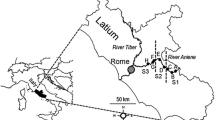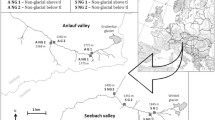Abstract
Research has established that there is a relationship between lotic macroinvertebrates and environmental variables; however, the sample is frequently large with a coarse mesh size, or sampling is broad in scope. My working hypothesis was that microhabitat variability affects habitat choice and community structure of larval chironomid midges, examined at a scale close to organismal size. Small benthic cores were taken monthly and divided vertically into 1 cm sections. Midge larvae were extracted from each section, and 14 environmental variables were assessed for each section. Partial canonical correspondence analysis indicated that a number of species showed unique microhabitat preferences. The species–environment relation was strong, in which several environmental variables contributed significantly to patterns of midge habitat structure, most notably current, depth in the sediment, and certain sediment fractions. This research demonstrated that small macroinvertebrates are selective in choosing microhabitats, measured at the rarely examined small scale close to organismal size, in a simple homogeneous sandy environment. Precision in defining an organism’s microhabitat can help us better to understand species habitat choices with a view to improve understanding of species interrelationships.




Similar content being viewed by others
References
Allan, J. D., 1995. Stream Ecology. Structure and Function of Running Waters. Chapman and Hall, London.
Barbour, M. T., J. Gerritsen, B. D. Snyder & J. B. Stribling, 1999. Rapid Bioassessment Protocols for Use in Streams and Wadeable Rivers: Periphyton, Benthic Macroinvertebrates, and Fish, 2nd edn, EPA 841-B-99-002. U.S. Environmental Protection Agency, Office of Water, Washington, DC.
Bazzanti, M., 2000. Ecological requirements of chironomids (Diptera: Chironomidae) on the soft bottom of the River Arrone, central Italy. Journal of Freshwater Ecology 15: 397–409.
Braccia, A. & J. R. Voshell Jr., 2006. Environmental factors accounting for benthic macroinvertebrate assemblage structure at the sample scale in streams subjected to a gradient of cattle grazing. Hydrobiologia 573: 55–73.
Coffman, W. P., 1989. Factors that determine the species richness of lotic communities of Chironomidae. Acta Biologica Debrecina Oecologica Hungarica 3: 95–100.
Coffman, W. P., 1995. Conclusions. In Armitage, P., P. S. Cranston & L. C. V. Pinder (eds), The Chironomidae: The Biology and Ecology of Non-Biting Midges. Chapman and Hall, London: 436–447.
Costa, S. S. & A. S. Melo, 2008. Beta diversity in stream macroinvertebrate assemblages: among-site and among-microhabitat components. Hydrobiologia 598: 131–138.
Death, R. G. & M. K. Joy, 2004. Invertebrate community structure in streams of the Manawatu-Wanganui region, New Zealand: the roles of catchment versus reach scale influences. Freshwater Biology 49: 982–997.
Epler, J. H., 2001. Identification manual for the larval Chironomidae (Diptera) of North and South Carolina. Version 1.0. North Carolina Department of Environment and Natural Resources Special Publication SJ2001-SP13, Raleigh, NC. http://www.esb.enr.state.nc.us/BAUwww/Chironomid.html.
Erman, D. C. & N. A. Erman, 1984. The response of stream macroinvertebrates to substrate size and heterogeneity. Hydrobiologia 108: 75–82.
Eyre, M. D., J. G. Pilkington, R. P. McBlane & S. P. Rushton, 2005. Macroinvertebrate species and assemblages in the headwater streams of the River Tyne, northern England in relation to land cover and other environmental variables. Hydrobiologia 544: 229–240.
Ferrington, L. C., 2008. Global diversity of non-biting midges (Chironomidae; Insecta-Diptera) in freshwater. Hydrobiologia 595: 447–455.
Galbraith, H. S., C. C. Vaughn & C. K. Meier, 2008. Environmental variables interact across spatial scales to structure trichopteran assemblages in Ouachita Mountain rivers. Hydrobiologia 596: 401–411.
Hynes, H. B. N., 1970. The Ecology of Running Waters. University of Toronto Press, Toronto, ON.
Jongman, R. H. G., C. J. F. ter Braak & O. F. R. van Tongeren (eds), 1995. Data Analysis in Community and Landscape Ecology. Cambridge University Press, Cambridge.
Lenat, D. R. & V. H. Resh, 2001. Taxonomy and stream ecology – the benefits of genus- and species-level identifications. Journal of the North American Benthological Society 20(2): 287–298.
Mackay, R. J., 1969. Aquatic insect communities of a small stream on Mont St. Hilaire, Quebec. Journal of the Fisheries Research Board of Canada 26(5): 1157–1183.
Merritt, R. W., K. W. Cummins & M. B. Berg (eds), 2008. An Introduction to the Aquatic Insects of North America, 4th ed. Kendall-Hunt Publ. Co., Dubuque, IA.
Palmer, M. A., P. Arensburger, A. P. Martin & D. W. Denman, 1996. Disturbance and patch-specific responses: the interactive effects of woody debris and floods on lotic invertebrates. Oecologia 105: 247–257.
Pennak, R. W., 1988. Ecology of freshwater meiofauna. In Higgins, R. P. & H. Thiel (eds), Introduction to the Study of Meiofauna. Smithsonian Institution Press, Washington, DC: 36–60.
Persson, A. & J. M. Svensson, 2006. Vertical distribution of benthic community responses to fish predators, and effects on algae and suspended material. Aquatic Ecology 40: 85–95.
Pinder, L. C. V., 1980. Spatial distribution of Chironomidae in an English chalk stream. In Murray, D. V. (ed.), Chironomidae: Ecology, Systematics, Cytology and Physiology. Pergamon Press, Oxford: 153–162.
Pinder, L. C. V., 1986. Biology of freshwater Chironomidae. Annual Review of Entomology 31: 1–23.
Punti, T., M. Rieradevall & N. Prat, 2009. Environmental factors, spatial variation and specific requirements of Chironomidae in Mediterranean reference streams. Journal of the North American Benthological Society 28(1): 247–265.
Rabeni, C. F. & G. W. Minshall, 1977. Factors affecting microdistribution of stream benthic insects. Oikos 29: 33–43.
Rae, J. G., 1985. A multivariate study of resource partitioning in soft bottom lotic Chironomidae. Hydrobiologia 126: 275–285.
Rae, J. G., 1987. The effects of flooding and sediments on the structure of a stream midge assemblage. Hydrobiologia 144: 3–10.
Rae, J. G., 1989. Chironomid midges as indicators of organic pollution in the Scioto River Basin, Ohio. Ohio Journal of Science 89(1): 5–9.
Rae, J. G., 1990. The effect of naturally varying discharge rates on the species richness of lotic midges. Hydrobiologia 196: 209–216.
Rae, J. G., 2004. The colonization response of lotic chironomid larvae to substrate size and heterogeneity. Hydrobiologia 524: 115–124.
Reice, S. R., 1980. The role of substratum in benthic macroinvertebrate microdistribution and litter decomposition in a woodland stream. Ecology 61: 580–590.
Robertson, A. L., 2000. Lotic meiofaunal community dynamics: colonisation, resilience and persistence in a spatially and temporally heterogeneous environment. Freshwater Biology 44: 135–147.
Sokal, R. R. & F. J. Rohlf, 1995. Biometry: The Principles and Practice of Statistics in Biological Research, 3rd ed. W. H. Freeman and Co., New York, NY.
Stribling, J. B., K. L. Pavlik & S. M. Holdsworth, 2008. Data quality, performance, and uncertainty in taxonomic identification for biological assessments. Journal of the North American Benthological Society 27(4): 906–919.
Stubbington, R., A. M. Greenwood, P. J. Wood, P. D. Armitage, J. Gunn & A. L. Robertson, 2009. The response of perennial and temporary headwater stream invertebrate communities to hydrological extremes. Hydrobiologia 630: 299–312.
Swan, C. M. & M. A. Palmer, 2000. What drives small-scale spatial patterns in lotic meiofauna communities? Freshwater Biology 44: 109–121.
ter Braak, C. J. F. & P. Smilauer, 2002. CANOCO Reference Manual and CanoDraw for Window’s User’s guide: Software for Canonical Community Ordination (version 4.5). Microcomputer Power, Ithaca, NY.
Thienemann, A., 1954. Chironomus: Leben, Verbreitung und Wirtshaftliche Bedeutung der Chironomiden. Binnengewasser 20. E. Schweizerbart, Stuttgart: 834 pp.
Tokeshi, M., 1994. Biodiversity in aquatic systems: some conceptual and theoretical issues. In Yasunu, M. & M. Watanabe (eds), Biodiversity: Its Complexity and Role. Global Environmental Forum, Tokyo: 211–275.
Tokeshi, M., 1995. Life cycles and population dynamics. In Armitage, P., P. S. Cranston & L. C. V. Pinder (eds), The Chironomidae: The Biology and Ecology of Non-Biting Midges. Chapman & Hall, London: 225–268.
Ward, G. M. & K. W. Cummins, 1979. Effects of food quality on growth of a stream detritivore, Paratendipes albimanus (Meigen) (Diptera: Chironomidae). Ecology 60: 57–64.
Waters, T. F., 1972. The drift of stream insects. Annual Review of Entomology 17: 253–272.
Weiderholm, T. (ed.), 1983. Chironomidae of the Holarctic Region, keys and diagnoses. Part 1. Larvae. Entomologica Scandinavica Supplement 19: 1–457.
Wene, G., 1940. The soil as an ecological factor in the abundance of aquatic chironomid larvae. Ohio Journal of Science 40: 193–199.
Wentworth, C. K., 1922. A scale of grade and class terms for clastic sediments. Journal of Geology 30: 377–392.
Acknowledgments
This research was funded by grants from the Francis Marion University Professional Development Fund. I would like to thank John Ludlam and Jeff Steinmetz for their comments on the MS and Kirk Dineley for aid with graphing. Big thanks are due to Broughton Caldwell who helped immensely in confirming or correcting identifications. Two anonymous reviewers helped refine the manuscript. Finally, my greatest thanks go to Susan for her steadfast help in the field.
Author information
Authors and Affiliations
Corresponding author
Additional information
Handling editor: Nuria Bonada
Electronic supplementary material
Below is the link to the electronic supplementary material.
Rights and permissions
About this article
Cite this article
Rae, J.G. Abiotic factors affect microhabitat selection and community dynamics in a sandy-bottom lotic chironomid midge assemblage. Hydrobiologia 700, 121–130 (2013). https://doi.org/10.1007/s10750-012-1223-9
Received:
Revised:
Accepted:
Published:
Issue Date:
DOI: https://doi.org/10.1007/s10750-012-1223-9




